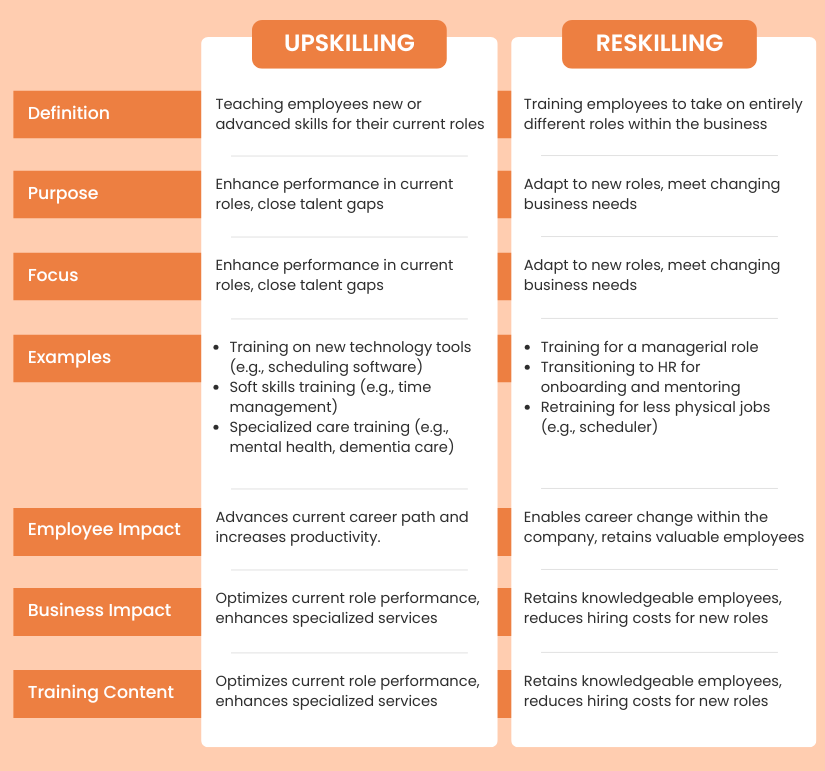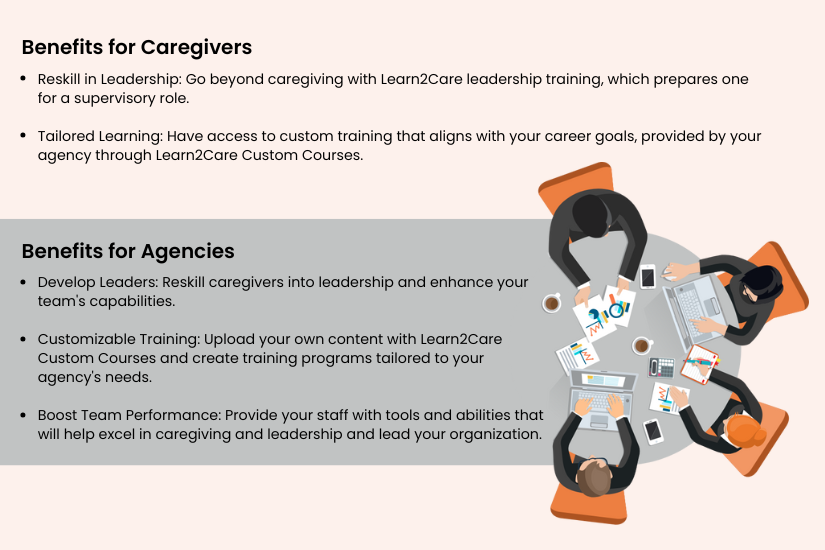
Spring is here! Birds are singing, flowers are blooming, and it’s a popular time to tidy up your career and reskill.
As we move into 2025, many home care businesses still face a caregiver shortage and high turnover rates. Attracting well-trained candidates to meet growth needs remains a challenge. To overcome this, some home care providers have made significant internal changes. These strategies include updating company culture, investing in automation software, and promoting career and personal growth opportunities among staff.
Reskilling caregivers is proving to be an effective strategy for closing the skill gap.
Reskilling involves training caregivers to take on different roles or responsibilities within your home care business. This essential caregiver training may not directly relate to their current job but can still benefit your company and align with the caregiver’s personal or career goals.
Here are some examples of reskilling:

Peer to peer learning takes the knowledge and the experiences of the employees in a specific organization. That is why your agency might have certain caregivers with rather high levels of proficiency in some spheres of caregiving. This way, you can build the skills you need without large expenses – make sure that such employees ‘teach,’ or mentor others. Peer to peer learning can be a one-on-one affair, or arranged in learning groups that could be in the form of a workshop.
This approach also makes it easier for caregivers to share and therefore the learning process is enriched with the different issues that may be arising. It also has an application area through which the caregiver can demonstrate what they have learnt in the safe environment of the simulated scenario. It is a way of nurturing and enhancing the caregiving competencies and the leader trainee’s interpersonal and people skills inclusive of, though not limited to, listening, feedback and communication.
Warning: Some learners are more qualified than others and can come up with excellent peer to peer training sessions once motivated by promises of special attention or incentives. The benefits of this transfer of knowledge and caregiver training are many, and the overall cost of this method of training is relatively small compared to other methods.
Another rich source of reskilling is through mentorship but unlike peer coaching, it is slightly different. In a mentoring relationship, a seasoned caregiver is teamed with a novice one with the aim of offering him/her direction. This is especially useful in orientation, with a new employee assimilating in the organization easily.
Mentors are also able to impart on job knowledge and skills, offer daily guidance and direction to the mentees, and enhance the scope of skill set available to the mentees depending on the need in the agency. Mentorship enhances learning within an organization in that internal resources are put to optimum use. It also has the wonderful effect of improving employee morale for the long term.
It’s important to set aside time for mentors and mentees to ensure the success of the program. Encourage mentors, recognize their efforts, and make sure the agency values the program.
In some cases, more than internal knowledge and experience may be required to meet specific training needs. Hiring freelance specialists or external training providers can fill these gaps. These experts bring the exact skills, competencies, and experience required to upskill your caregivers quickly.
Group sessions led by external trainers can enhance both hard and soft skills. They also offer an opportunity to bring remote team members together, strengthening connections and teamwork. Many agencies are increasingly hiring external trainers for stress management and mindfulness skills to prevent caregiver burnout. These are crucial skills in the demanding field of home care.
External caregiver training solutions can offer a fresh perspective and introduce new techniques and practices that benefit your team significantly. Although a cost is involved, the return on investment regarding improved caregiver skills and satisfaction is well worth it.
Promoting a bottom-up approach to learning empowers caregivers to take charge of their professional development. Through regular appraisals or coaching sessions, managers can identify the skills caregivers want to develop. This information can then be used to create personalized reskilling pathways.
Provide incentives and remove barriers to support caregivers in developing their own learning plans. Paid online caregiver training time, provide additional resources, and offer flexibility for attending workshops and seminars. Rewards or added benefits for caregivers who reskill on their own time can also be motivating.
Another effective strategy is to create promotional opportunities within your agency for those who successfully reskill. Gamifying the process by rewarding employees who achieve certain reskilling milestones can make learning more engaging and fun.
Technology-based caregiver training offers the advantage of flexibility and affordability compared to face-to-face classes. Online platforms provide courses that can be attended at specific times, but e-learning is preferred because it allows learners to complete lessons at their own pace. Most caregiver training programs are designed to be flexible, enabling learners to progress according to their schedule.
Online learning providers offer structured programs that lead to recognized certifications. Additionally, short one-time training programs, such as certificates, can also benefit the home care industry.
Webinars and video conferences provide an opportunity for caregivers to learn from home while engaging actively in the content. These programs can be further enhanced by creating microlearning resources, such as short training modules or stand-alone webcasts. While creating this content requires an initial investment of time and resources, it becomes a valuable tool for ongoing staff training and development.
After completing online lessons, caregivers can access manuals and quick reference guides to help with onboarding. Additionally, implementing a caregiver Learning Management System (LMS) can create a potential income stream by offering training services to other agencies or as part of a home care business offering.
Encouraging caregivers to attend industry seminars, training courses, and other events can be highly beneficial. These events provide opportunities to stay updated on trends, gain new knowledge from experts, and interact with others in the field. Families attending these events can share their insights when they join your agency as caregivers.
While seminars and events involve some costs, they also bring valuable knowledge and ideas that can benefit the team. Ensure that caregivers who attend these events are able to share what they’ve learned with the rest of the staff through in-house training sessions.
Custom in-home caregiver training is an effective way to reskill caregivers. Instead of sending multiple caregivers to costly external courses, consider selecting one representative to attend and then share the knowledge with the team. This “train-the-trainer” model is efficient and helps distribute information throughout the organization.
Look for employees with the skills and experience needed to become in-house trainers. To motivate them, consider offering rewards such as a salary increase, additional paid leave, or even a promotion. This approach is especially beneficial since in-home caregiver training can be tailored to your agency’s specific needs, making the sessions highly relevant and practical.
To successfully measure the success of reskilling initiatives, one must understand key caregiver and organizational development indicators. Some of the key indicators of success are mentioned below:
A non-growing caregiver team in an unprogressive agency will not secure or maintain the best talent available in the market. This is key in assessing the current ability of the agency to meet future needs; the deficiencies are then closed through seeking advanced caregiver training in methods that allow caregiver reskilling.
In any case, developing a workforce reskilling program requires that the process becomes institutionalized as an aspect of your business management plan and ethos. Organizational leaders and managers are required to promote learning in day-to-day practice through job training and development; and performance appraisal.
Honestly, if you are seriously thinking of elevating your caregiving team or you just want to ensure that your caregivers do not cross professional boundaries, Learn2Care is a must-visit resource.
Here’s what we bring to the table:

So, what are you waiting for? Upskill your team with Learn2Care, and watch your caregivers become certified caregiving professionals.
Contact us to inquire about our state-wise training courses and take the first step towards upskilling your team with a 14-day free trial!